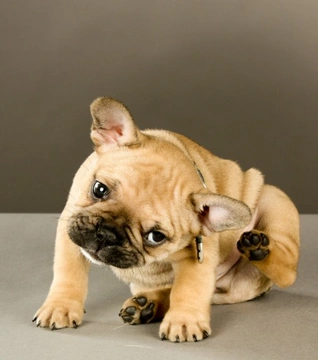
What flat-faced puppy owners need to know about puppy acne
Puppy acne is instantly recognisable to most people who have had acne themselves, but this is not always the case as many puppy buyers don’t even realise that puppies can get acne at all! Puppy acne tends to present in pups as they go through puberty (much as usually happens with people) and begin to become sexually mature.
This tends to be around 5-8 months of age for most dog breeds, including the vast majority of flat-faced dogs. However, giant breeds can be rather later in the development stakes.
Puppy acne is actually fairly common, and many pups regardless of breed or whether or not they’re flat faced will develop spots at some point, and generally these will go away without much hassle by the time the dog reaches adulthood.
However, acne in flat-faced dogs is more common than in other breeds and types , and can also be more problematic for a number of reasons. It is important then for the owners of flat-faced puppies to understand the basics of puppy acne in brachycephalic breeds, and ensure they know what signs to look out for and the steps they can take to reduce the likelihood of their own dogs developing acne.
Read on to learn more about puppy acne in flat-faced dog breeds.
What dog breeds are most prone to puppy acne?
As mentioned, puppy acne is a fairly common thing and any breed of dog can develop it. However, it is more common in flat-faced breeds than others. There could potentially be a hereditary element to this, meaning that certain breeds and breed lines of brachycephalics have a genetic predisposition to spots; but their conformation and facial features (and general skin presentation) makes puppy acne more common in flat-faced breeds.
Why? Well, flat-faced breeds have very wrinkled skin and skin folds across their face and sometimes, body; when they reach puberty, their hormone levels change and can make their skin more sensitive, as well as increasing oil and sebum production. The skin folds of the face (and possibly other areas) also trap and collect shed skin cells, moisture and dirt, setting up the perfect environment for spots to develop. Dogs with short coats and flat faces are those most likely to suffer from puppy acne.
Four of the breeds most commonly associated with puppy acne are the boxer, the English bulldog, the French bulldog, and the Rottweiler.
The symptoms of puppy acne in flat-faced dogs
Acne on puppies usually takes the form of whiteheads or pustules (what most of us think of when we think of acne) but it can also come in crops of red pimples or blackheads too.
Whiteheads are most likely to get noticed as they stand out more, and if your pup has blackheads, particularly on dark skin, you might feel these as an area of the skin that feels rougher than normal rather than actually seeing them clearly.
Some acne breakouts will bother your pup and be itchy, irritated or sore, which might make them rub their face against things or scratch their face a lot.
Also, acne is highly likely to develop within skin folds, which means you might not see them as easily, so always check within skin folds as well as on the visible parts of the skin; which you should be doing anyway as part of cleaning and drying your flat faced dog’s wrinkles.
Around the chin and muzzle are the main areas to look for spots, and the face tends to be affected more often than the skin of the body, although for dogs with heavy wrinkling they might develop acne that will drive them to distraction across much of their body. English bulldogs in particular are at risk for this.
Preventing or reducing acne breakouts in flat-faced dogs
Because there’s a heavy hormonal element to puppy acne and it might even be genetic in some breeds, it is not always possible to prevent a breakout from occurring; this is the case for any dog, not just flat faced ones.
However, acne tends to be more acute and can be harder to resolve in flat-faced dogs, and if you are vigilant about their care, there are ways you can prevent or reduce the severity of some breakouts.
Essentially this means taking excellent care of the dog’s facial (and body if relevant) skin folds, which is something you should begin doing when your dog is a puppy and getting them used to early on, as this care is needed for the rest of your dog’s life.
Clean right inside of your dog’s skin folds with a clean damp cloth, using a gentle skin wash (or veterinary medicated product if advised) to remove grime, dead skin and shed hair, and vitally, always dry the skin folds thoroughly with a clean, dry cloth too.
Always wash these cloths after use to avoid contaminating the skin next time, and change the cloth as needed if it gets mucky while you are working.



